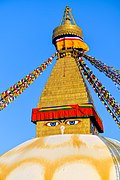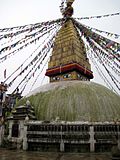Prominent Buddhist shrines in Nepal
Swayambhunath is one of the oldest known stupas in Nepal.Stupas in Nepal date back to the Licchavi period ; a stupa is a mound -like or hemispherical structure containing relics (such as śarīra Buddhist monks or nuns ) that is used as a place of meditation.[ 1] Swayambhunath is one of the oldest known buildings in the country and was likely built in the 5th century.[ 2] Kathmandu , where the land was declared as sacred to Siddhartha Gautama (Buddha), by the 3rd Emperor of the Maurya Dynasty Ashoka the Great in the 3rd century BCE.[ 2] sacred lotus at the centre of Kathmandu when the city was a lake .[ 3]
Ashoka's daughter Charumati , who married a Nepali prince, built Charumati Stupa in the 4th century.[ 4] [ 5] Boudhanath is one of the holiest sites in Nepal, it was closed for 18 months after the April 2015 Nepal earthquake , which completely destroyed the top part of the stupa.[ 6] Annexation of Tibet by the People's Republic of China , many refugees from Tibet started to settle in the area and convert it into a "Little Lhasa ".[ 7] [ 8] Kaathe Swayambhu , a replica of the Swayambhunath that was built in 1650, is located near Thamel .[ 9] [ 10] Lumbini , the place where, according to Buddhist tradition, Queen Mahamayadevi gave birth to the Buddha, there are several stupas including World Peace Pagoda , Myanmar Golden Temple , and Great Drigung Kagyud Lotus Stupa .[ 11]
The World Peace Pagoda was built by Japanese Buddhists for about US$1 million; near the stupa is the gravestone of a monk who was murdered by an anti-Buddhist group while the building was being built.[ 12] Ramagrama stupa contains the relics of the Buddha and it remains untouched in its original form.[ 13] [ 14] World Heritage Site by the United Nations Educational, Scientific and Cultural Organization (UNESCO).
List of stupas
See also
References
^ Mark, Joshua J. (1 September 2020). "Stupa" . World History Encyclopedia Archived from the original on 8 September 2020. Retrieved 8 September 2020 . ^ a b c Láscar, Jorge (3 September 2020). "Swayambhunath Stupa" . World History Encyclopedia Archived from the original on 8 September 2020. Retrieved 8 September 2020 . ^ Pant, Shaswat (13 October 2017). "Swayambhu: The eyes that keep watch over Kathmandu" . OnlineKhabar . Archived from the original on 9 September 2020. Retrieved 9 September 2020 . ^ "Charumati facelift" . Nepali Times . January 2004. Archived from the original on 9 September 2020. Retrieved 9 September 2020 .^ Regmī, Jagadīśacandra (1972). Temples of Kathmandu OCLC 1504633 . Archived from the original on 9 September 2020. Retrieved 9 September 2020 . ^ "Nepal's earthquake-hit Boudhanath stupa reopens after restoration" . The Guardian . 22 November 2016. Archived from the original on 9 September 2020. Retrieved 9 September 2020 .^ Sherwood, Seth (4 February 2009). "In Frenetic Katmandu, Finding a Quiet Space" . The New York Times . ISSN 0362-4331 . Archived from the original on 9 September 2020. Retrieved 9 September 2020 . ^ Bhattarai, Sewa (28 December 2018). "The stupa of a million dewdrops" . Nepali Times . Archived from the original on 8 September 2020. Retrieved 9 September 2020 . ^ a b "Kathesimbhu Stupa" . Lonely Planet . Archived from the original on 9 September 2020. Retrieved 9 September 2020 .^ Aryal, Suprasanna (22 May 2013). "Amidst Fluttering Prayer Flags" (PDF) . Friday . Archived (PDF) from the original on 9 September 2020. Retrieved 9 September 2020 . ^ "Lumbini, the Birthplace of the Lord Buddha" . UNESCO World Heritage Centre . Archived from the original on 9 September 2020. Retrieved 9 September 2020 .^ "World Peace Pagoda" . Lonely Planet . Archived from the original on 8 September 2020. Retrieved 9 September 2020 .^ a b Kandel, Prakriti (22 March 2019). "The Buddha was born in Lumbini" . Nepali Times . Archived from the original on 8 September 2020. Retrieved 8 September 2020 . ^ a b "Ramagrama Stupa" . World Heritage Journeys . Archived from the original on 8 September 2020. Retrieved 9 September 2020 .^ Gutschow, Niels (1997). The Nepalese Caitya: 1500 Years of Buddhist Votive Architecture in the Kathmandu Valley ISBN 9783930698752 Archived from the original on 8 April 2014. Retrieved 8 April 2014 . ^ "Boudhanath Stupa" . Lonely Planet . Archived from the original on 8 September 2020. Retrieved 8 September 2020 .^ DHARLO, Nyanang Bhusepa Rinchen (1 January 2020). The Buddhist Holy Sites of Nepal: The Songs of Marvelous Conversation ISBN 978-93-87023-96-3 Archived from the original on 9 September 2020. Retrieved 8 September 2020 . ^ Huntington, John C.; Bangdel, Dina (2003). The Circle of Bliss: Buddhist Meditational Art ISBN 978-1-932476-01-9 Archived from the original on 9 September 2020. Retrieved 8 September 2020 . ^ McDaniel, Justin Thomas (1 April 2017). Architects of Buddhist Leisure: Socially Disengaged Buddhism in Asia's Museums, Monuments, and Amusement Parks ISBN 978-0-8248-7440-7 Archived from the original on 9 September 2020. Retrieved 8 September 2020 . ^ "Exotic sites and wild creatures" . Bangkok Post . 2 February 2020. Retrieved 8 September 2020 .^ Weismantel, Julia (21 July 2020). Kathmandu lieben lernen: Der perfekte Reiseführer für einen unvergesslichen Aufenthalt in Kathmandu inkl. Insider-Tipps, Tipps zum Geldsparen und Packliste ISBN 978-3-7519-7362-5 Archived from the original on 8 September 2020. Retrieved 8 September 2020 . ^ a b Reed, D.; McConnachie, J. (2002). The Rough Guide to Nepal . Music rough guide. Rough Guides. ISBN 978-1-85828-899-4 ^ Turner, Elen (24 January 2020). "10 Architectural Treasures to Visit in Nepal" . Architectural Digest . Archived from the original on 8 September 2020. Retrieved 8 September 2020 . ^ "Votive stupa" . Archaeological Survey of India . Archived from the original on 8 September 2020. Retrieved 8 September 2020 .^ J Das, Hengul. "World Peace Pagoda" . The Times of India . Archived from the original on 8 September 2020. Retrieved 8 September 2020 . ^ Majupuria, Trilok Chandra; Majupuria, Indra (1979). Glimpses of Nepal: Ancient & Modern Glories of a Charming Country OCLC 475316611 . Archived from the original on 8 September 2020. Retrieved 8 September 2020 . ^ Reed, David (2002). The Rough Guide to Nepal ISBN 978-1-85828-899-4 Archived from the original on 9 September 2020. Retrieved 8 September 2020 . ^ "World Peace Pagoda" . World Heritage Journeys . Archived from the original on 8 September 2020. Retrieved 8 September 2020 .











